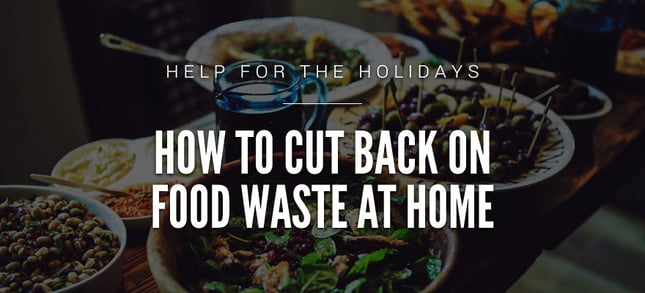Help for the Holidays: How to Cut Back on Food Waste at Home

Thanksgiving is right around the corner. For most of us, this holiday revolves around a full-table feast with turkey galore and all the festive trimmings. Delicious? Yes! But unfortunately, also wasteful in many cases. We thought this month presented a great opportunity to highlight some of the things we can (and should) be doing to reduce waste at home. Not just for this one holiday, but for the entire year.
Now, we typically focus on strategies to reduce waste in foodservice operations and not at the consumer level. But, we also recognize that all of our readers eat at home, and at the consumer level, we throw away an average of 25% of our food purchases in the U.S.—25%!
Fortunately, Dana Gunders, Staff Scientist at the National Resources Defense Council, recently released the Waste Free Kitchen Handbook. It’s chock full of great information and practical tips to reduce that typical 25% at-home waste down to nearly nothing. Gunders reminds us that wasting less food isn’t about one big action or change; it’s about a series of small changes to our daily routine. Here are a few of the ideas highlighted throughout the book:
Meal Planning
It’s essential that you know what you’re going to eat, if you’re going to shop smart. One of our LeanPath clients recently told me he’s on a two-week meal cycle at home, and strategically plans out dishes in a sequence where leftover items can be re-used. That’s the idea here, and the Handbook offers a sample meal plan along with a template for planning out your own.
Waste Diagnostics
It probably goes without saying that this is our favorite section at LeanPath. Conduct a food waste audit to understand what you’re wasting. Do this by keeping your usual cooking routine, and write down all the food you toss in a log book. This way, you can see exactly what you threw away and why, then adjust. And if you want to get granular, use a scale or a paper bag with lines marked to measure exact amounts of waste.
Smarter Storage
First, you need get to know your fridge and its settings so you can utilize it to the fullest (like putting carrots and salad in your high-humidity drawer, and apples and peppers in your low-humidity drawer.) Make a “use soon” bin that’s prominently displayed, or tape a list to the refrigerator door with items that need to be eaten soon. (Hint: a magnetized dry-erase board is perfect for this.)
Rely on Your Freezer
The “food waste warrior’s best friend,” your freezer can help you preserve foods for much longer than they would survive in a fridge or on the shelf. Nearly everything can be frozen, and Gunders provides tips for proper prepping, packing and thawing.
Many of these tips also apply to that Thanksgiving dinner you might be cooking up next week (or just eating, if you’re lucky). Plan your menu and shop smart. Get a head count of your expected guests and approximate portion sizes as best you can. Ask your guests to bring Tupperware or other to-go containers, so they can take home some of those delicious leftovers (and freeze them if they aren’t going to eat them right away).
With a little planning and resourcefulness, you can significantly cut back on food waste at home, doing your part for the environment and your wallet!
To learn more about the Waste Free Kitchen Handbook by Dana Gunders, click here.
For waste warrior tips for your commercial kitchen, check out our newest free e-guide below.
